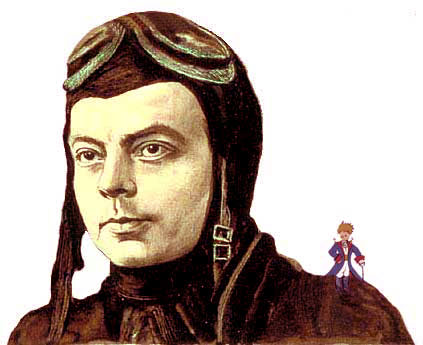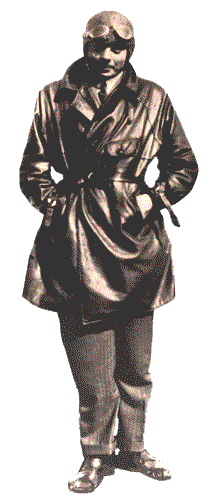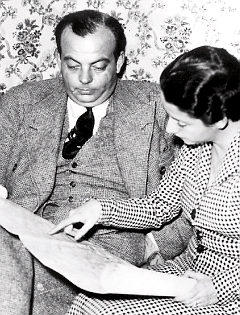
|
The Life and Times of Antoine de Saint-Exupéry by David Langley |
||
|---|---|---|---|
| Home Page | Airmen Index | ||

|
|||
|
Antoine de Saint-Exupéry (29 June 1900—31 July 1944) was a French writer and aviator and is most famous for his novella, The Little Prince (1943). He was a real life hero who looked at adventure and danger with poet's eyes—sometimes from the viewpoint of a child. During World War II Saint-Exupéry served as a pilot and went missing while flying in a Lockheed P-38 Lightning on a reconnaissance mission over France in 1944. | |||
 |
In 1998, a fisherman named Jean-Claude Bianco was working in the Mediterranean Ocean off the coast of Marseille, France. As a storm approached, he hauled in his trawling net and found an engraved bracelet entangled in it. Upon examining the item, Bianco was startled to see a man’s name that he recognized immediately. Authorities who also looked at the bracelet decided that the item probably was a fake—that is, until a scuba diver later working near Bianco’s fishing area discovered the bracelet’s source: an airplane wreck on the ocean floor. The damaged plane was a reconnaissance aircraft from World War II. And the name on the bracelet was none other than that of the French author and flyer Antoine de Saint Exupéry, now known around the world for his 1943 children’s book entitled The Little Prince. |
| Fisherman Jean-Claude Bianco discovered the bracelet of Antoine de Saint Exupéry. |
|
|
Antoine Marie Jean-Baptiste Roger de Saint-Exupéry was born in Lyon, France in 1900 into a family with long-established roots in the French aristocracy. His family included an ancestor who fought with the American revolutionaries at the Battle of Yorktown in 1781. His father was the Viscount Jean de Saint Exupéry—an insurance executive who suffered a fatal stroke in 1904. His mother, Marie de Fonscolombe, was—according to her son—a beautiful, intelligent, and caring woman.
After the Viscount died, Marie moved with her five children to the Castle of Saint-Maurice-de-Remens, northeast of Lyon. This castle was owned by one of her aunts, the Countess de Tricaud. While growing up there, the children lived a fairly carefree life, listening to their mother’s inventive stories, playing in the countryside, and staging plays and musicals. In 1909, the family moved to the home of Antoine’s paternal grandfather in Le Mans, in central France. (Just a year earlier, Wilbur Wright had come to Le Mans and overwhelmed ordinary citizens and leading French aviators with amazing flying displays in his Wright Flyer.) While living in Le Mans, Saint-Exupéry attended a Jesuit school called Notre Dame de Sainte Croix. During the summer of 1912, he enjoyed his first airplane ride with (some sources say) the French aviation pioneer Gabriel Wroblewski. |
|
|
Life quickly became more complicated for the young man. In June 1914, Archduke Ferdinand of Austria-Hungary was killed by a Serb assassin. The nations of Europe started forming opposing military alliances as Austria-Hungary and Serbia waged war. World War I began in earnest on August 1, when Germany declared war on Russia. In spite of the war, Saint Exupéry and his younger brother, Francois, started attending the Jesuit school of Notre Dame de Montgré at Villafrance, near Lyon. In November 1915, as the war grew worse, the two brothers moved to the Villa Saint-Jean school in Fribourg, Switzerland.
In the spring of 1917, Saint Exupéry passed his baccalaureate examination. In June of 1917, American troops arrived in France to help the Allies in World War I. About the same time, Saint Exupery’s brother, Francois, died of rheumatic fever. In the fall of that year, Saint Exupéry moved to Paris and attended classes at the Lycee Saint Louis, a leading college preparatory school. He then sought to enter the French Naval Academy, in Brest. In June 1918, however, he failed the oral part of the entrance test. He therefore entered the School of Fine Arts in Paris and studied architecture for fifteen months. Meanwhile, World War I ended in November of 1918 with the Allies victory over Germany. In April, 1921, Saint Exupéry began his required two years of French military service. He went to Strasbourg, in southeastern France, for training as a pilot. In June, he took his first flying lesson in a Farman aircraft. One month later, he soloed in a Sopwith plane. In December of 1921, he obtained his military pilot’s license and then served briefly in North Africa. Saint Exupéry then returned to Paris, where he fell in love with Louise de Vilmorin in the winter of 1922. In early 1923, Saint Exupéry fractured his skull in an airplane accident, his first of several crashes during his life. Realizing that her fiancé was committed to a dangerous profession, Louise broke off the engagement. |
|
|
In 1924, Saint Exupéry became a part-time mail pilot. In 1926, he published his first story, “The Aviator,” in the literary magazine Le Navire D’Argent, edited by Jean Prevost. That same year, his oldest sister, Marie Madeleine, died after a long fight with tuberculosis.
In October of 1926, Saint Exupéry began flying for the Latecoêre Line based in Toulouse. He flew the mail through France, Spain, and northern Africa. In 1927, he started spending much of his time in Dakar, Senegal, and began learning about the Sahara desert and its people. Late in the same year, he became director of the Cap Juby airfield in the Rio de Oro region of the Sahara. As station chief, he made friends with both the Spanish authorities and Arabs of that region. His close relations with both groups helped him to rescue downed mail pilots and to mediate disputes between the two groups. In 1929, Saint Exupéry published his first novel, Courrier Sud, or Night Mail. That same year, he moved to South America and quickly became director of an airmail company called Aeroposta Argentina. Along with Saint Exupéry, one of the company’s first pilots was his fellow Frenchman Henri Guillaumet. Two other Frenchmen, Jean Mermoz and Marcel Reine, also helped to carry the mail. |
 |
|
Two years later, in 1931, Saint Exupéry published his second novel, Vol de Nuit, or Night Flight, which won the Prix Feminina, a major French literary prize. That same year he married Consuelo Gomez Carillo, the widow of Enrique Gomez Carrillo, a Guatemalan diplomat and journalist. She herself counted among her friends the Nobel Prize winner Maurice Maeterlinck and the Italian novelist, poet, and dramatist Gabriele D’Annunzio. Despite outward appearances, the Saint Exupéry marriage was unsettled, especially because of the flyer’s long absences while flying—and a few extramarital affairs!
In 1932, an English-language version of Night Flight appeared in the United States. And a year later, Southern Mail was published in the USA by Reynal and Hitchcock. That same year, Hollywood adapted Night Flight for the big screen. The movie starred John Barrymore as the main character, Rivière. The film also contained other stars, including Lionel Barrymore, Clark Gable, Myrna Loy, and Helen Hayes. On a December, 1935 flight, Saint Exupéry and his navigator Andre Prevot crashed their plane in the Sahara desert. The aviator walked in the desert for a few days before being rescued by a Bedouin caravan. In 1936, he returned to his writing life and covered the May Day events in Moscow. That same year, war returned to Europe in the form of the Spanish Civil War. General Francisco Franco, supported by Adolf Hitler’s Germany, began his eventually successful overthrow of the left-leaning Spanish government. Saint Exupéry wrote a series of articles on the war for the French newspaper, The Intransigent. In 1937, Saint Exupéry returned to flying, having bought a Caudron Simon aircraft to replace the one that he had lost in the Sahara. A year later, he crashed again, this time in Guatemala, and suffered injuries from which he never fully recovered. In 1939, he published Terre des Hommes, or Land of Men, a record of his flying adventures in South America and North Africa. The book won the French Academy’s 1939 Grand Prix du Roman. That same year, the novel appeared in the United States as Wind, Sand, and Stars and won the National Book Award. The film director Jean Renoir wanted to shoot a film version of the novel, but no one would finance it. On September 1, 1939, World War II began when Germany invaded Poland, and then Great Britain and France declared war on Germany. Saint Exupéry, despite his flight injuries, joined the French air force to fly reconnaissance missions. However, in May of 1940, German forces finally overwhelmed the French and entered Paris. Saint Exupéry joined the Free French forces, but his air squadron eventually was demobilized. |
|
|
The flier escaped from France and eventually made his way to New York City, where he first lived in Manhattan near the southwest corner of Central Park. During his absence from France, the Vichy régime appointed Saint Exupéry to its National Council, but he protested strongly against this supposed honor. Although he opposed the German occupation, he received criticism for his weak support of de Gaulle's Free French forces. In his defense, he published a public letter to his countrymen in the New York Times.
On Sunday, December 7, 1941, World War II suddenly turned even more violent with the Japanese surprise attack on Pearl Harbor. The very next day, the United States Senate and House declared war on Japan. The Axis powers promptly declared war on the United States, so on December 11 the U.S. declared war on Germany and Italy as well. |

Saint Exupery and his wife Consuelo. |
|
By 1942, with France still under control of Nazi Germany, Saint Exupéry had moved into a house in Asharoken, on Long Island’s north shore. While living there, he started writing and illustrating a children’s book based on his earlier flying exploits. He also worked on a memoir of his reconnaissance flights in a Potez 637 aircraft over France in 1940. This memoir, called Flight to Arras, appeared in the United States in 1942.
In 1943, Saint Exupéry finally published his best-known work, The Little Prince, in both French and English. The story is a children’s fable for adults and has been translated into over 100 languages. It has been described as the best-selling book in the world after the Bible and Karl Marx’s Das Kapital. According to the Books and Writers website, “Its narrator is a pilot who has crash-landed in a desert. He meets a boy, who turns out to be a prince from another planet. The prince tells about his adventures on Earth and about his precious rose from his planet. He is disappointed when he discovers that roses are common on Earth. A desert fox convinces him that the prince should love his own rare rose, and finding meaning to his life, the prince returns home.” Saint Exupery’s actual life did not turn out as happily as that of the little prince. As the Allied cause strengthened, his French reconnaissance squadron was reconstituted, and he rejoined the group in North Africa. In light of his flight injuries, he continued to face opposition from senior officers about flying. In July of 1944, he was scheduled for one of his last flights. On July 31, he took off from an Allied airbase in Borgo, Corsica, headed for the Grenoble region in southern France to take reconnaissance photos. His plane, a Lockheed P-38 Lightning, disappeared that same day. His squadron declared him officially missing on September 8. |
|

Saint Exupery in his Lockheed P-38 Lightning. |
|
|
In the days and weeks that followed, various parties speculated that Saint Exupéry was shot down over the Mediterranean, had a flight accident, or even committed suicide. The latter theory grew out of the fact that the flyer had felt isolated from his squadron and was pessimistic about the future. On a previous mission, however, he had simply had trouble with his oxygen mask and almost passed out.
At his death, Saint Exupéry left behind an unfinished book that eventually appeared in France as La Citadelle. In 1948, after Saint Exupery’s American publisher Curtice Hitchcock died, Eugene Reynal merged their publisher firm into Harcourt Brace. 1n 1950, Harcourt Brace published La Citadelle in English under the title The Wisdom of the Sands. Saint Exupery’s mother outlived her son and died in 1972, at age 92. His widow, Consuelo, died seven years later. She is buried in the famous Pere-LaChaise cemetery in Paris, next to her first husband. In 1986, Harcourt Brace published a collection of the flyer’s wartime writings. But what—precisely—caused the pilot-author’s death? In 2000, a diver named Luc Vanrell located the remains of Saint Exupery’s P-38. A Luftwaffe pilot from World War II, Horst Rippert, hearing that Saint Exupery’s plane had been found, said that he had shot down the French flyer. In modern-day interviews, Rippert says that—as a youth—he had read the flyer’s writings and would not have fired on Saint Exupéry if he had known who the Frenchman was. However, military records and interviews with other surviving Luftwaffe pilots raise doubts about Rippert’s claim. In 2003, a salvage team brought major pieces of the aircraft to the ocean’s surface. Accident examiners confirmed the plane’s identity by its serial number. But the examiners also found no bullet holes or other combat damage in the remains. Luc Vanrell believes that Exupéry purposely crashed his plane, but most historians say that the specific cause of the famous pilot-author’s death remains a mystery to this day. | |
|
David Langley is a freelance writer who resides in New York. |
Return to Airmen Index
© The Aviation History On-Line Museum.
All rights reserved.
May 4, 2009.